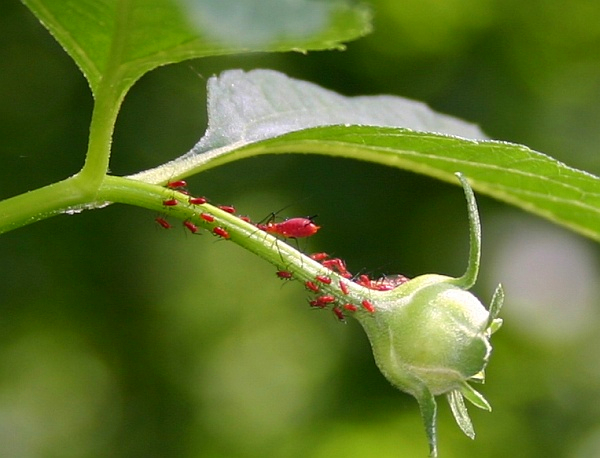
As soon as the woodland sunflowers started to bloom in Schenley Park their stems became coated with tiny red bugs. Last weekend I took the camera to the Upper Trail to see what the red was all about.
It didn’t take long to figure out these are red aphids. Nose down, probiscus inserted, they sucked the sunflower juices. They only ate from the Helianthus species, never from other plants nearby.
Among the hundreds of aphids I found a few with wings, the dispersal generation that can fly to new hosts. In the photo above there’s a winged adult hiding behind the flower bud.
Most fascinating was their wide range of sizes. From incredibly tiny to full grown adults there were many generations on one plant. I saw no larvae, just fully formed bugs, because of their incredible reproductive strategy.
In the summer all aphids are female! They reproduce asexually and give birth to live young. In the photo above, the large aphid is the mother, the tiny ones daughters. Some species of aphids can telescope generations. Like Russian nesting dolls, the mother aphid has a daughter inside her who is pregnant with a daughter inside her. No wonder there are so many of them!
In fall aphids switch to a different reproduction method. The females give birth to males, mate with them, and lay eggs that overwinter and hatch as females.
Since they’re so small aphids are vulnerable to wind, rain and predators. I blew on an infested stem and watched them crowd to the leeward side. You can zap them off your garden plants by spraying them with a hose. Or you can hire some ladybugs or lacewings to do the job. (Lacewing larvae are nicknamed “aphid lions.”)
With such a bumper crop of aphids I’m on the lookout now for their predators. In this bug-eat-bug world that’s what will happen next.
(photo by Kate St. John)
Totally fascinating. Super column today, Kate. Never knew about the reproduction methods. Nature can be incredibly stunning.
Several times, in the wilds of the Allegheny National Forest, I witnessed the phenomenon of ” aphid ranching”. Underneath rocks, a certain species of ant herds and corrals aphids in an example of symbiotic relationship. The aphids provide sugar for the ants and the ants provide protection and security for the aphids. Watching this spectacle happen was so absorbing that I completely forgot my reason for being there, turkey hunting. Thus, the whole aphid story gets curiouser & curiouser.
I usually see these on Goldenrod stems…Don’t like these “suckers.”
What is the species name for this plant?
Carol, I didn’t identify it down to the species. I was too busy looking at the aphids.